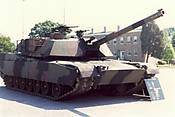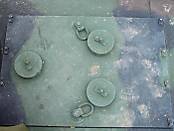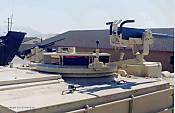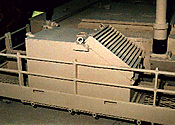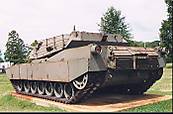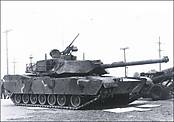1⁄35M1 Variants
15
Comments

M1 Abrams Tank Variants
The Abrams series started with the XM1 prototype that became the M1. Based on feedback from the troops in the field, certain modifications were added to those initial M1s in the field and to M1s during production. These became known as M1IP or M1 Improved Production. This variant was equipped with the M68 105mm main gun and had an asymmetrical 3-blast panel configuration. M1IPs can be identified from an M1 by the rear turret bustle rack and the redesigned turret ammo blast panels (went from 3 asymmetrical to two identical panels). All fielded XM1 and M1 tanks were brought up to M1IP standards (less test/evaluation tanks and museum pieces). The engine access cover does not have the two rear inspection hatches. The front fenders do not have the “X” stamping and the head light guards are straight across as opposed to the later stepped type. Also, there are sponson boxes on both sides of the hull.The M1A1 was up gunned to the 120mm smooth bore cannon. It also added an NBC over pressurization system in place of the left hull sponson (storage) box. A "man hole cover" was added forward of the loader's hatch in anticipation of the development of Commander's Independent Thermal Viewer (CITV). The CITV was not installed on any M1A1 though. Other changes include the engine access cover having two rear inspection hatches added. The front fenders had “X” stamping for strength and the head light guards are the later stepped type. About the same time as the M1A1HC changes were being made (still during ODS), the Abrams changed track from the angled-block T-156 track to the square-block, “Bigfoot”, T-158 track.

The Marines made some cosmetic changes to their Abrams as well. They added a Missile Countermeasures Device (MCD) on top of the manhole cover. This is the square device that some people confuse for a version of the CITV. It serves a totally different purpose by directing anti-tank guided missiles away from the tank. The Marines do not use the CITV. They also swapped the Army 6-shot smoke grenade launcher for a double stack 4-tube version for 8 smoke launchers on each side of the turret. They also added a Tank Infantry (TI) phone to the right rear hull to allow ground troops to communicate with the tank crew for mutual support. Lastly, the USMC has started putting the track retaining ring or "Training Wheels" back onto their M1A1s. Originally developed for the M1IP the USMC started putting these on M1A1s that were stationed stateside in the early-mid nineties. It was an easy fix to counter the track losing tension during operation and reduced the numbers of track being thrown.
The M1A2 was the next step. It added a new digitized electronics package and the CITV. The CITV allows the commander to search and designate targets while the gunner engages the current target. This tank also incorporated an auxiliary power unit (APU or basically a generator) in the turret bustle rack to power the optics and electronics without the need to run the turbine engine. The APU has been retrofitted to many M1A1s as well. The M1A2 also required a new commander's cupola because the CITV data screens took up too much room in the commander's hatch.
The final variant (so far) is the M1A2SEP or Systems Enhancement Program. This upgraded several internal systems and allowed the APU to be moved from the turret bustle to the inside of the left rear hull (Under Armor APU or UAAPU). The engine was changed as well and the CITV now uses a 2nd generation FLIR. The biggest difference in the SEP is the new engine, smaller, more fuel-efficient (hence the removal of one fuel tank for the APU) and the same power. It also has a new Thermal Management System (Air Conditioner, mainly for all the electronic components) and part of it, the Vapor Compression System Unit (VPSU), is now in the turret bustle rack where the EAPU used to be in an M1A1/A2. There are also some new electronics installed in the SEP. All SEPs are rebuilt tanks that may have been M1IP or M1A1. Very few units in the Army use the M1A2SEP.

If you're asking why versions of the M1A1 are made after the M1A2, the answer is money. The Army can't afford any more M1A2 or M1A2SEP. Most units that did not get the M1A2 SEP (non III Corps units) are receiving M1A1 AIM tanks to equip their units.
The current US inventory consists of M1IP, M1A1 and M1A1HC in the National Guard. The Regular Army has M1A1HC, M1A1 AIM, M1A1D, and M1A2 SEP depending on the unit.
M1 Abrams APUs
Hull mounted APUs were used up until about 1993, after that the turret mounted APU was introduced in the M1A1 Heavy Common. Original M1A2s still had turret bustle APUs as well. The M1A2 SEP (Systems Enhancement Program) has an internal APU mounted in the left side of the rear hull.Comments
Thank you, Gino for such an outstanding article! Strong work, and judging by Dragon's list of upcoming M1 kits it's gonna get a whole lot of use I am sure.
MAY 07, 2005 - 12:25 AM
A very nice article Gino....
Thanks, now I understand just a little more.
MAY 07, 2005 - 02:25 AM
Thanks for the Great INFO. I have alot of M1's Abrams to do and this info on the feature is a wonderful HELP.
This will help me with super-detailing the special items on a M1's Abrams.The pictures are truely helpful and it shows alot of detail.
I can not wait for you to do a feature on a Paladin because you would be a wonderful help for a Paladin feature.
Happy Modeling
(++) 1:35
MAY 07, 2005 - 10:11 AM
A great reference. I know some question about M1 variants comes up about once or twice a month. This, way we can point them to a complete history. Awesome job!
Jeff
MAY 07, 2005 - 11:26 AM
I have a question regarding the AIM program. The article is a little unclear with that.
Is the M1A1-D only a digitalized M1A1 HC, or also rebuilt as M1A1 AIM before receiving the digital equipment?
Thomas
MAY 08, 2005 - 07:21 AM
M1A1D is a rebuilt M1A1 under the AIM program, or an upgraded M1A1HC. What makes it a D is that it has the Applique Digital Systems from an M1A2 (FBCB2, EPLRS, Blue Force Tracker, etc.) added to it as well. It was designed as an interim vehicle that could talk to M1A2s and M1A2 SEPs and was fielded until divisions could be fully fielded with M1A2s and M1A2 SEPs. On a further note, as reported by the good MAJ Rob (Sabot) in his recent post, all M1A1Ds have been returned to depot and stripped of their Applique Digital Systems and will be brought back up to M1A1 AIM standards.
OCT 21, 2005 - 06:40 AM
Gino - I have a couple small corrections to offer regarding the difference between the M1 and M1-IP.
As an M1 crewman, I served with H Co., 2/2 ACR, in Bamberg, Germany, from early 1985 to late 1986. The M1's that we had were fairly new, the squadron having transitioned to M1's a few months before I got there.
The vehicles we had were production M1 with the original 3-piece blowout panels and canvas webbing on the back of the turret for stowage.
During a rotation thru Grafenwöhr for gunnery, I had occasion to see the new M1-IP. Granted, not up close, but I did notice that the wind sensor was T-shaped, as opposed to the straight cylinder of the M1. It did have the steel turret bustle rack, and at the time, we were pretty jealous. The webbing...
In 1986, all of our vehicles had the webbing removed and the steel bustle rack added. So, this in itself isn't a distinguishing feature of the M1-IP. According to GlobalSecurity.org, there were very few M1-IP's actually made, production having been shifted over to the M1A1.
Regards - Dan
MAR 09, 2007 - 02:10 AM
Thanks. I have since heard of a few minor variations to what I posted. I have heard of both types of wind sensors being used as well. Guess there was no one set type in those early transition years.
MAR 09, 2007 - 02:27 AM
Thanks for the interesting read Gino. I am not much of a follower of the modern era armor but it is good to know how a certain piece of equipment evolved into what it is today.
Everytime I see an M1 tank I see a little of the MBT-70.
Jeff
MAR 09, 2007 - 02:46 AM
OMG :-) please, one of the moderators help me and delete my message before everyone can see how stupid I am...
MAR 09, 2007 - 06:00 AM
Copyright ©2021 by Gino P.Quintiliani. Images and/or videos also by copyright holder unless otherwise noted. The views and opinions expressed herein are solely the views and opinions of the authors and/or contributors to this Web site and do not necessarily represent the views and/or opinions of Armorama, KitMaker Network, or Silver Star Enterrpises. All rights reserved. Originally published on: 2005-05-06 00:00:00. Unique Reads: 65274





